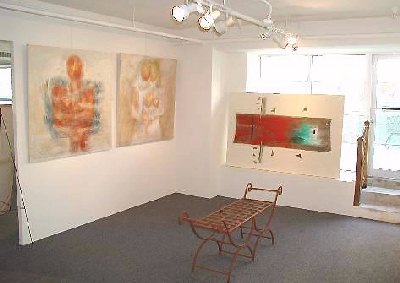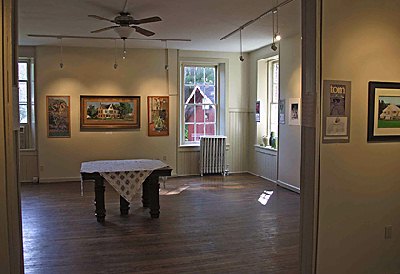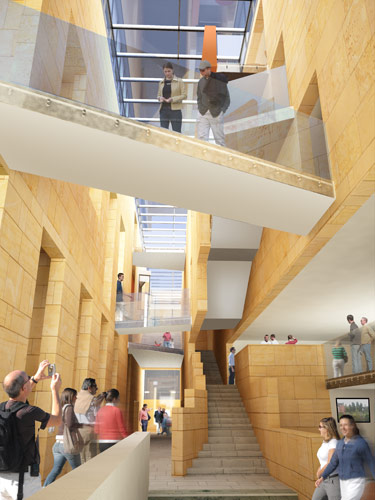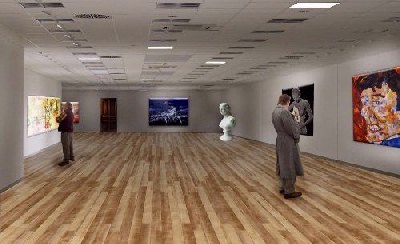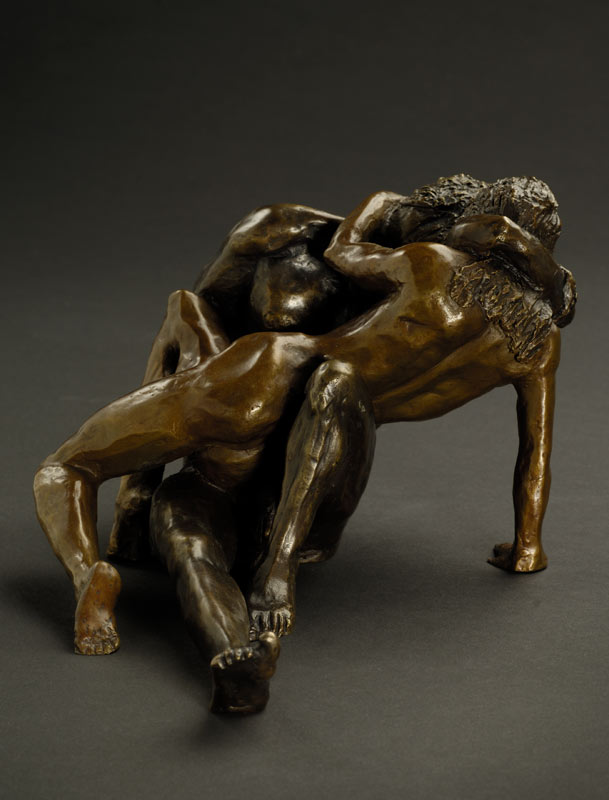| White Box Gallery
The Art History Archive - Contemporary
Rethinking Art Galleries in the 21st CenturyBy Charles Moffat - 2008. Most art galleries, sad to say it, fall into the category of a white box. The walls are plaster and painted white, creaky wooden floors and a counter behind which regularly sits the curator or one the gallery monitors. Devoid of art, the room(s) are exceptionally boring and to some extent intimidating because they so formal and business like. In 2002 I was a member of a committee to redesign the Akasa Gallery and what we did was something dramatically different. We set up 3 barriers inside the room, made of stainless steel with small holes punctured in every half inch of the steel. So instead of hanging the paintings or frames on the wall you hook them into the steel holes (resulting in very low maintenance as the gallery operators don't have to fix the plaster every 1 or 2 weeks). The barriers encouraged people to walk around the gallery more often and because they were double sided it meant quite a few paintings could be shown in a relatively small space. The committee suggested we add benches to the gallery so that people could sit down, but this idea was turned down because the operators wanted people to walk around more and wanted to discourage visitors from just "lounging around". There are plenty of other options galleries have these days to change how their gallery is perceived and works.
1. Plants - I am a firm believer that plants can make galleries a brighter and more welcoming place. Because some people are allergic to flowers I recommend leaning towards bamboo, cacti, ivy, wisteria (which blooms only once/year) and other leafy plants. 2. Smell - An unusual thought, but scented candles or incense can also change the feel of the art gallery and make visitors feel more at home. 3. Seating - Benches, chairs, barstools and sofas offer a more welcoming and relaxed atmosphere. Visitors can sit and take in the artwork, allowing them to fully enjoy what they are looking at instead of just walking through and leaving. 4. Music - Classical music, jazz music, it doesn't matter. Any kind of music will engage a visitor's ears and add an extra dimension to the experience. I favour French-Canadian celloist Jorane, but to keep the gallery monitors happy I recommend a variety of different musicians and catering more to the monitor's taste.
5. Walls - The gallery walls do not have to be white. They could be black, steel, striped, polkadotted or any combination of colours. Depending on the artwork shown the artist might favour a complementary or contrasting colour. 6. Floors - A plain cement floor is the worst possible choice, and wooden planks is only marginally better. I am not suggesting people purchase carpet however. That is a big no-no, but a stainless steel floor is also possible and brick is another interesting option. One of the most interesting galleries I've ever been in had patterned bricks for the floor and the walls were made of clay tiles (the gallery I am speaking of was in Insadong, Seoul, South Korea). 7. Food/Drink - Offering beverages and food in a gallery may feel like the gallery is becoming more of a restaurant, but don't we already serve wine, crackers and cheese (amongst other foodstuffs) during openings? There is a solution however if the gallery in question has a basement or a loft in which the gallery could open an adjoining bar or restaurant. For safety purposes you will want a sign inbetween the two sections saying "No Food or Beverages Beyond This Point".
8. Multimedia - Imagine entering a gallery and seeing a television in the corner or behind the counter which shows art documentaries, interviews with artists and video art pieces. Alternatively a computer kiosk setup to show information about the artist, possibly with a digital projector to show the information on the wall instead of a screen. Expensive perhaps, but eye catching. Imagine entering a gallery with cello music playing in the background, has comfortable wooden benches scattered around the various rooms, plants by the windows and the front desk and a bar at the back which serves bubble tea for $4 each. This isn't just an art gallery any more, its a place to meet people for first dates and drink bubble tea together while chatting about art. Art galleries have the potential to be doing a lot more than what they are currently doing. I find it pathetic that so few galleries have seating and the curators/owners haven't put more thought into what they put into the space. Sex and Race in Contemporary GalleriesIn terms of power structures women have a tendency to be ignored in gallery settings. If you want into a gallery and see a man and a woman behind the counter, who is the curator and/or who is the artist? People bring their own assumptions when they walk into an art gallery about what they expect the artist or curator to be. If the artworks present are nude sculptures of women you might expect the artist to be male and quite surprised when they turn out to be from a female artist. In North America people "expect" artists to be white men. It is just the standard we've been raised with. Words like doctor, painter, sculptor, photographer are all considered gender neuter, but because there is no female equivalent of those words we have a tendency to expect the person in question to be male. For matters of race people have a tendency to forget that all humans make art, and do so in many styles and using many methods they acquire. Just because a painting is done in a modern Western style doesn't mean the person doing it is of European descent. And the same goes for paintings exercising Asian or African techniques or motifs. An excellent example of these ideas is Candice Raquel Lee, an African-American artist who makes bronze nudes, frequently using stories from Greek and Middle-Eastern mythology. Why is this important? Because frankly women and people from different ethnic backgrounds are often ignored when applying to be shown by galleries. Despite a healthy percentage of artists from other backgrounds (and in particular women who study art professionally in college and university), white men still dominate the art gallery scene. At the university where I studied art about 70 to 80% of the students were female. This says to me that women take art more seriously than men and it is rather surprising that a very small portion of those female artists go on to pursue careers as artists. My hunch is they have been turned down by galleries after many attempts and end up moving on to other career goals.
|
|
